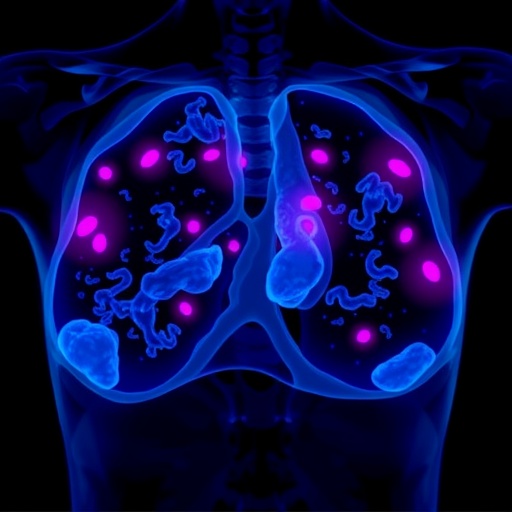Tumor-infiltrating lymphocytes (TILs) have increasingly become a focus in oncological research due to their crucial role in mediating the immune response to cancer. In an illuminating new multicenter retrospective study conducted across Chinese populations, researchers have explored the predictive capacity of TILs for neoadjuvant chemotherapy (NAC) response and long-term outcomes in breast cancer patients. This large-scale analysis offers significant insights, potentially redefining prognostic stratification and therapeutic decision-making in breast cancer treatment paradigms.
This study incorporated data from 424 breast cancer patients treated between 2013 and 2023 at two prestigious institutions: Ruijin Hospital affiliated with Shanghai Jiao Tong University School of Medicine and Quanzhou First Hospital affiliated with Fujian Medical University. The research team meticulously evaluated pre-treatment tumor biopsies to quantify TIL levels, adhering strictly to the guidelines provided by the International Immuno-Oncology Biomarker Working Group. This standardized assessment ensured high reproducibility and accuracy in correlating immune infiltration with clinical outcomes.
The researchers utilized restricted cubic spline (RCS) regression modeling to capture potential nonlinear associations between continuous TIL measurements and pathological complete response (pCR) rates post-NAC, as well as breast cancer prognosis. This advanced statistical approach facilitated the identification of a precise TIL cutoff value most indicative of favorable therapeutic response, a critical aspect often lost in binary or arbitrary stratifications.
Remarkably, the analysis revealed that a TIL threshold of 10% optimally discriminated responders from non-responders to neoadjuvant therapy within this cohort. Patients exhibiting TIL levels above this threshold were considered to have high TIL expression, accounting for approximately 34.7% of the population studied. This subgroup demonstrated a strikingly elevated pCR rate of 29.3% compared to just 8.7% among patients with TIL levels below 10%, underscoring the potent predictive value of immune cell infiltration prior to systemic treatment.
Delving deeper into the statistical outputs, logistic regression models estimated the odds ratio for achieving pCR as markedly higher in patients with elevated TILs, with an OR of 0.29 and a 95% confidence interval spanning 0.16 to 0.52 (p < 0.001). This robust association suggests that immune-rich tumor microenvironments confer enhanced sensitivity to neoadjuvant chemotherapy, possibly through mechanisms involving immune-mediated tumor cell clearance or improved chemotherapeutic efficacy in an inflamed milieu.
The prognostic significance of TILs extended beyond immediate treatment response. Patients with lower TIL expression faced a substantially increased risk of disease recurrence, with a hazard ratio (HR) of 2.36 (95% CI: 1.47–3.80, p < 0.001), reinforcing the notion that the immune contexture of tumors may dictate not only short-term therapeutic outcomes but also long-term disease trajectories. This comprehensive follow-up, spanning a median of 95 months, provided ample temporal scope to validate TILs as enduring biomarkers.
Survival analyses further elucidated the impact of TILs on overall survival (OS). Univariate Cox regression confirmed that low TIL levels were significantly associated with diminished OS (HR: 2.22, 95% CI: 1.17–4.19, p=0.014). Although multivariate adjustments tempered this association somewhat, the trend persisted, indicating that TILs convey prognostic information independent of conventional clinical and pathological factors.
Intriguingly, subgroup analyses stratified by breast cancer molecular subtypes yielded insights into differential immunologic dynamics. High TIL levels correlated with improved breast cancer-free interval (BCFI) and OS specifically in patients diagnosed with triple-negative breast cancer (TNBC), a notoriously aggressive and heterogeneous subtype that traditionally lacks targeted therapies. These findings align with the hypothesis that TNBC tumors may leverage immunogenicity as a therapeutic vulnerability, underscoring the potential for immunomodulatory strategies in this cohort.
Conversely, in hormone receptor-positive (HR+), HER2-negative breast cancers, TIL density did not demonstrate significant correlations with therapeutic response or survival. This suggests that the immunologic milieu’s influence varies substantially depending on tumor biology, which has crucial implications for the deployment of immune biomarkers and immunotherapies across different breast cancer subtypes.
The optimal TIL cutoff of 10% delineated in this study may provide clinicians with a practical and evidence-based metric to refine pre-treatment prognostication. Unlike prior studies employing heterogeneous thresholds, this evidence supports standardized inclusion of TIL quantification in routine pathological evaluation prior to systemic therapy initiation.
The revelation of TILs as both predictive and prognostic biomarkers in this extensive Chinese cohort enhances the global understanding of breast cancer immunobiology. It contributes foundational data that may inform personalized treatment strategies, such as intensifying NAC regimens in patients with low TILs or considering immunotherapy augmentation in TNBC patients harboring high TIL profiles.
Furthermore, this study exemplifies the power of rigorous statistical modeling in uncovering nuanced biologic relationships. The application of RCS regression allowed for a refined exploration of TIL thresholds, moving beyond simplistic dichotomizations and enabling a more granular understanding of immune-tumor interactions.
Collectively, these findings advocate for the integration of TIL assessment in contemporary clinical protocols, serving as a non-invasive, cost-effective biomarker to enhance prediction accuracy for response to neoadjuvant therapy and long-range outcomes in breast cancer patients. The translational potential of this research is vast, laying the groundwork for future prospective trials targeting the immune microenvironment.
As immunotherapy revolutionizes oncology, the ability to stratify patients based on innate immune activity within tumors takes on paramount importance. This investigation substantiates the premise that TILs, reflective of host anti-tumor immunity, can guide tailored therapeutic interventions, possibly improving survival rates and minimizing unnecessary treatment toxicities.
In conclusion, the study robustly establishes tumor-infiltrating lymphocytes as pivotal determinants of both response to neoadjuvant chemotherapy and subsequent prognosis in breast cancer, with pronounced implications for triple-negative and HER2-positive subtypes. These data warrant further exploration in diverse populations and prospective settings, with the ultimate goal of harnessing tumor immune profiles to optimize therapeutic outcomes worldwide.
Subject of Research: Tumor-infiltrating lymphocytes as predictive and prognostic biomarkers in breast cancer neoadjuvant therapy response and survival outcomes.
Article Title: Predictive value of tumor-infiltrating lymphocytes for neoadjuvant therapy response and prognosis in breast cancer: a multicenter retrospective study based on Chinese population.
Article References:
Li, L., Yang, P., Hong, C. et al. Predictive value of tumor-infiltrating lymphocytes for neoadjuvant therapy response and prognosis in breast cancer: a multicenter retrospective study based on Chinese population. BMC Cancer 25, 1585 (2025). https://doi.org/10.1186/s12885-025-15022-x
Image Credits: Scienmag.com




